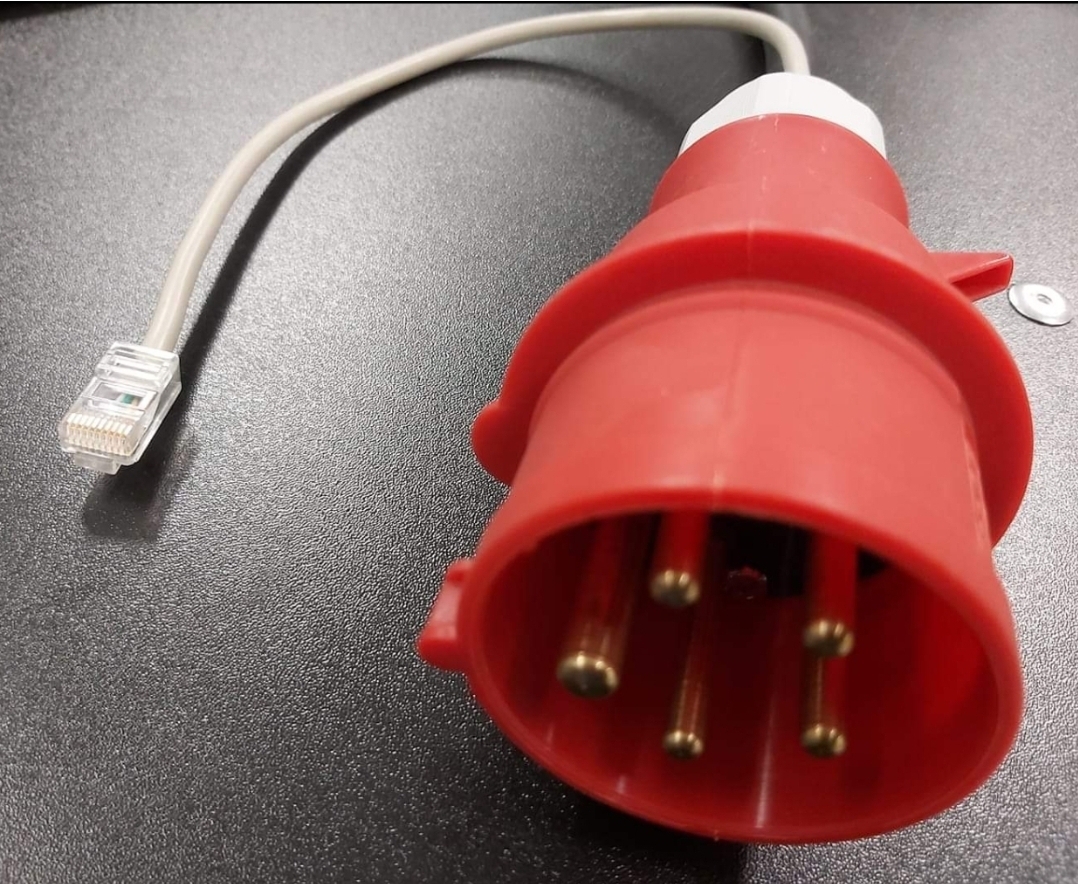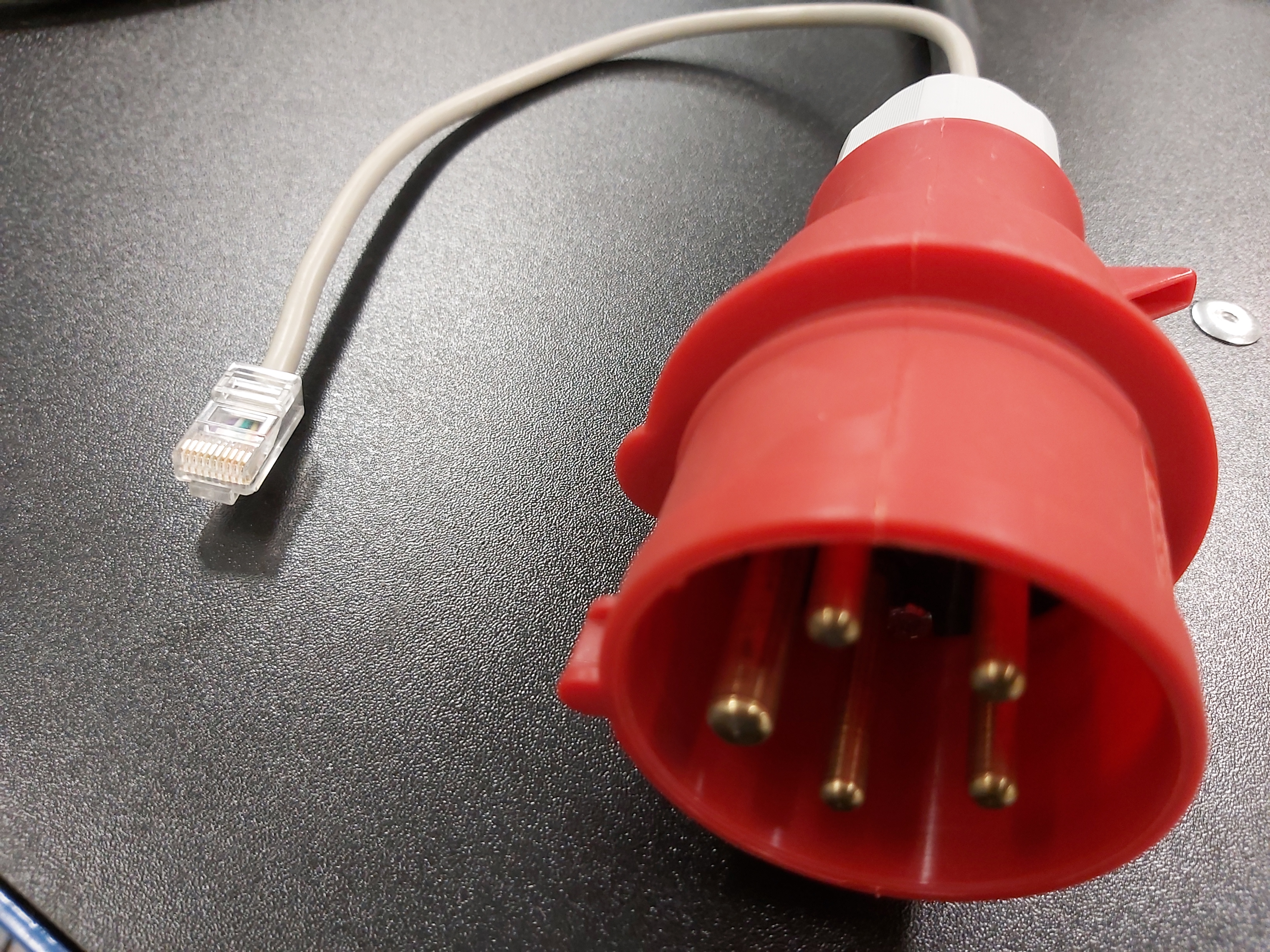Ethernet Killer is well known meme in many versions.
Fiftythree.org presents: The Etherkiller and Friends says”
“It all started one day with this guy, the origional Etherkiller, developed with a few misc parts to warn new users that the IT department is not to be messed with. You too can make one at home, connect the transmit pins of the RJ-45 to HOT on 110VAC and the recieve pins to Common. Modify to suit tase by varying pinout.”
There is also an European 230V AC versions of Ethernet Killer using SCHUKO and europlug. Check the video Ethernet killer in action – YouTube
Well you shouldn’t be just plugging anything except approved computers onto your production network….
Trying to use those can lead to expensive damages, fire and electrocution.
Please don’t show those pictures to normal users. They might actually think it’s a valid Ethernet over Power interface….
It is said that if something is worth doing, it is worth overdoing.
I got the power!
More than with often posted lame “Ethernet killer” cables with basic mains plug.
Do not try this anywhere.
I have not tested to really plugging this to anything. It is potentially very dangerous.


24 Comments
Tomi Engdahl says:
https://www.google.com/search?q=ethernet+killer
Tomi Engdahl says:
Some technical bits
This is the extra compact power sourcing equipment (PSE). It can theoretically support over 10 kW, but there is a danger that the Ethernet cable starts to get hot at only few kilowatts.
Magic smoke releaser!!
Looks like it will fry the cable before the power even reaches the device?
If you are lucky it might not fry the cable. Just tested an Ethernet cable with insulation tester – passed 1000V DC insulation test from wire to wire with RJ-45 installed. When current exceeds few amperes continuous the Ethernet cable will become quickly hot.
Something like 500 mA per wire should not be a problem.
Keep in mind there exists 600V Industrial Ethernet Cable – would it make the idea more safety compliant?
https://www.belden.com/blogs/600v-industrial-ethernet-cable-safety-and-nec-considerations
Any high voltage RJ-45 connectors?
Tomi Engdahl says:
https://electronics.stackexchange.com/questions/130341/current-over-cat6-ethernet-cable
Some CAT6 cable is rated as low as 60°C, and some is AWG 24, so if your ambient could be as high as 50°C. the current limitation might be as low as 2-3A. See, for example, this and this.
Edit: If the length could be as long as 10m, and assuming AWG24 size– resistance is nominally 84 ohms/km so 0.84Ω
/10m, so three in parallel, round trip, would be 0.56 ohm at 20°C. If 5% voltage drop (250mV) was acceptable, that would be a current of 440mA maximum, so maybe 350-400mA maximum allowing for temperature.
802.3at Type 2 POE limits the current to 600ma per “mode” (pair of pairs) which is equivilent to 300ma per core.
So if you assume the IEEE got it right then you can safely deliver about 900ma on a setup with three positive wires and three negative wires. I expect the IEEE were pretty conservative to allow for less than ideal installation methods and that with a single cable in free air you could go somewhat higher.
It depends on whether cable is 24 or 23 awg, and what length of cable, and whether pure copper or copper around aluminium.
I would suggest between roughly 1.5 amps and 2.2 amps based on quality of cable based on googling limit for power transmission on 23 and 24 gauge wire, lowest end for cheapest copper clad aluminium 24 gauge wire.
Longer length of wire you suffer from voltage drop because only 5volt power, normally in POE applications they step it up to 48v and then step down again to 5 volt.
Please, stick to the NFPA 79 Standard, Table 13.5.1, which specify the allowable ampacities for conductors with smaller sections (30 AWG to 10 AWG) than the NEC ampacities (14 AWG to 2000 kcmil).
This standard rates 2A for 24 AWG, 90 deg., single conductor.
And considering 8 carrying conductors inside a same cable, we should apply a 70% derating factor, with an estimate of 1.4A for 24 AWG, 90 deg., 8 carrying conductors.
This consider could vary according specific manufacturer certifications. Also, this assumes a CAT6 Cable as 24 AWG.
Tomi Engdahl says:
This is not actually a real thing built, almost.
But could be done and propably will not immediately explode, while terribly going over specifications and all safety regulations. RJ-45 and some cables are officially rated for 125V, but on my tests they can withstand 230V AC or 500V DC between pins… having neutral on pins 3 and 6 the 230/400V could possibly pass throug – not recommended and dangerous.
Tomi Engdahl says:
Adapter Drehstrom auf Gardena
https://etel-tuning.eu/produkt/adapter-drehstrom-auf-gardena/
Tomi Engdahl says:
By the way the size of the USB C plug is such that it is possible to insert it to an US outlet. The USB C connector just fits to the wider prong hole in the US connector (slightly too big for thinner prong hole). It is even possible to make the USB connector to make contact with the metal parts inside the connector (depends somewhat on the USB C connector and outlet construction if it can make contact).
Fortunately the wider prong connects the neutral wires (wires carrying unused electricity back to the breaker panel), so it does not shock you badly if the outlet is correctly wired.
It is the narrow prong that connects the hot wires (wires carrying electricity from the panel to an outlet or a switch). And USB C cannot fit into this.
Tomi Engdahl says:
IEEE 802.3wtf
Tomi Engdahl says:
Depending how ethernet killer is wired, this can fry the ethernet transformers (making it not working) or let the smoke out if Bob Smith termination resistors (port can be left on still works but with worse EMC performance).
Tomi Engdahl says:
802.3POW!
Tomi Engdahl says:
Ethernet killer in action
https://youtu.be/KsjAOPvQgII
Tomi Engdahl says:
3PoE
802.3”wtf”
Tomi Engdahl says:
Poe 400v 3 phase+n
Tomi Engdahl says:
DoE : Death over Ethernet. IRL Killware.
Tomi Engdahl says:
“If it’s worth doing, it’s worth overdoing.”
Ayn Rand
https://www.goodreads.com/quotes/37300-if-it-s-worth-doing-it-s-worth-overdoing
Tomi Engdahl says:
About ceeform connectors
https://youtu.be/feCZs9YpH3M
Tomi Engdahl says:
Ethernet killer
https://youtu.be/KsjAOPvQgII
Tomi Engdahl says:
PoE for electric cars
Three Phase Ethernet!
3ph 230/400VAC, 16A. I don’t think that little rj45 will handle what the other thing’s gonna give it. (~10kW max)
“Please observe all arc-flash safety precautions.”
Tomi Engdahl says:
RJ-45 current rating 1.5Amps Dielectric withstanding voltage 1000Volts AC RMS 60Hz, 1 minute Contact resistance ≤ 20mΩ @ 100mA max.
https://futurereadysolutions.com/wp-content/uploads/ONE-RJ45-Connectors-Datasheet-190107.0.pdf
https://www.eevblog.com/forum/projects/rj12-rj45-rj50-max-current-per-pin/
The actual name for the connector is “modular connector”. Yes, the name sucks, using generic adjective isn’t a good idea for naming things, but just FYI to help search. Further piece of the name is 8p8c, or 6p4c, or 6p2c, depending on how many contacts the plastic housing has, and how many are actually populated with the contacts.
Now <0.5A definitely isn't a problem of heating too much
The active resistance of UTP is about 1O \$\Omega\$ at 10m = 2 \$\Omega\$ in both directions.
The thing that kills RJ45 contacts (and most connectors) is sparks/arcing when connecting.
And PoE also protects against this – power is not supplied immediately, but after load matching.
Tomi Engdahl says:
http://www.fiftythree.org/etherkiller/
page has also BNC and VGA killers
Drive killer, floppy killer, SCSI killer, IDE killer, BD25 killer
Bus Killer version 2 fits PCI, ISA, and AGP
Tomi Engdahl says:
A new networking device is storming the market, it’s performance will shock you!
Tomi Engdahl says:
Maybe FOE (Fire Over Ethernet)
Tomi Engdahl says:
More like DOE.
Death Over Ethernet
Tomi Engdahl says:
PYRO OVER ETHERNET
Tomi Engdahl says:
When you need “clean” power for electronics.
Maybe more effective than one meter special power cable?
What is the purpose of live line washing ?
https://www.electricaltechnology.org/2024/04/live-line-washing-maintenance-cleaning.html